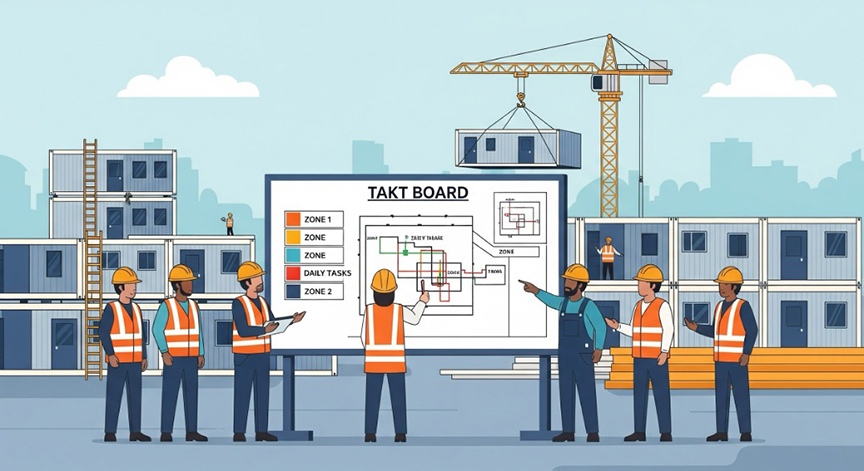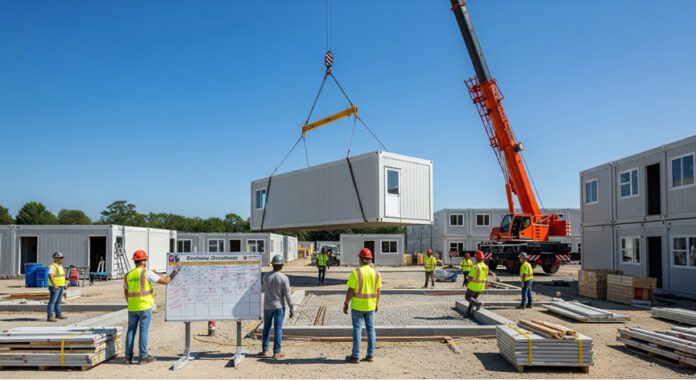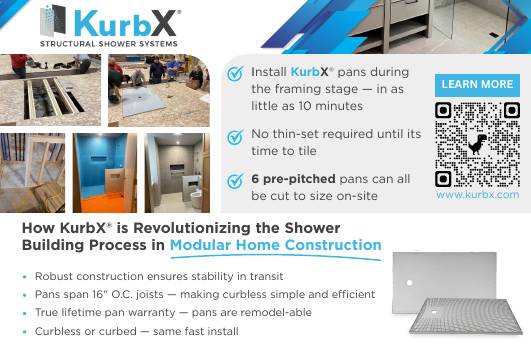Maintaining the rhythm of a jobsite Lean flow is a daily discipline. These tools make it possible.
- Lean jobsite scheduling uses takt time, crew balancing and visual systems to maintain steady project rhythm and reduce costly delays.
- Daily discipline is key. Morning huddles, visual boards and feedback loops ensure real-time adjustments and continuous improvement across teams.
- A well-synced schedule aligns factory output with field installation, minimizing downtime, boosting morale and enabling modular builders to deliver faster, smoother and more profitable projects.
In the first three articles of this series, I identified the challenges of on-site inefficiencies, explored how Lean tools like 5S and visual management bring order to the jobsite and showed how synchronizing offsite production with on-site assembly bridges a critical gap. But even with a perfectly organized site and great communication, there’s one more piece of the puzzle: the need to keep the flow going, day after day.
Lean flow isn’t a one-time setup — it’s a daily discipline. Schedules can fall apart quickly if crews are overextended today and waiting around tomorrow. Materials may arrive in perfect sequence, but if the team’s rhythm breaks down, the whole system suffers. That’s where Lean scheduling tools come in.
This article dives into the practical tools that help offsite and on-site teams stay in sync: Takt time as the drumbeat, crew balancing to prevent bottlenecks and visual systems to manage daily work. Together, these tools create a repeatable, predictable cadence that keeps projects moving smoothly from start to finish.

Why Schedules Fall Apart
Even the most well-planned projects can spiral into chaos if the daily work rhythm isn’t managed carefully. In modular construction, this often shows up as crews working at an uneven pace — overloaded with work one day, then waiting for materials or the crane the next. Early gains made through factory efficiency and strong coordination can be lost when field teams are stuck fighting problems rather than following a steady plan.
The hidden costs of reactive scheduling add up fast. Idle equipment burns time and money. Crews pulled in multiple directions make mistakes. Rework and overtime chip away at margins. Meanwhile, the project timeline stretches as small delays compound.
These issues aren’t unique to modular — but they hit harder when you’re trying to integrate offsite and on-site workstreams. Without a clear system for pacing the work, even small disruptions ripple through the schedule.
That’s why Lean scheduling is more than just a calendar — it’s a system for managing flow. And it’s the next step in building a truly synchronized offsite and on-site operation.
Tools That Keep Work Flowing
So how do you keep the rhythm going day after day? Lean scheduling relies on a few key tools that work together to create stability and predictability.
First is takt time — the heartbeat of a Lean schedule. Takt time sets the pace of work across the entire system, defining how much time each task or zone should need based on the customer’s required delivery rate. For modular projects, takt time helps align the speed of factory production with the pace of field installation. When the takt plan is clear, crews know what they need to accomplish each day to stay on schedule.
Next is crew balancing. Matching the right number of workers to each phase of the work ensures that no one is overloaded or sitting idle. Crew balancing helps avoid bottlenecks, reduces wasted labor and keeps productivity steady across zones and tasks.
Finally, visual scheduling systems make the plan real and actionable. Takt boards, visual plans and daily huddles give teams a clear picture of what needs to happen, where and when. These tools make it easy to see whether the work is on pace, identify issues early and adjust without chaos.
Together, takt time, crew balancing and visual systems form a feedback loop that keeps the project moving in rhythm — day after day, module after module.

Continuous Improvement
Lean scheduling is not about sticking rigidly to a plan though — it’s about learning and adjusting as you go. Daily huddles are the heartbeat of this process. In these short, focused meetings, teams review what was accomplished yesterday, what’s on deck today and what obstacles might get in the way. Crews might also update the takt board using color-coded magnets or cards to show task status, helping everyone see at a glance where the day’s work stands.
Equally important are feedback loops that tie lessons learned back into the system. Data from factory production rates, field crew performance and punch lists help teams fine-tune takt plans, rebalance crews and refine visual tools. Continuous improvement means treating each day as a chance to get better — streamlining handoffs, smoothing out bottlenecks and adapting to real-world conditions.
A Lean scheduling system isn’t static — it’s a living, breathing process that thrives on feedback and teamwork. It’s how offsite and on-site teams stay in rhythm, even when the unexpected happens.
An Example in Practice
Imagine a modular housing project where Lean scheduling principles are fully embraced. The team develops a takt plan that aligns factory production with field installation, ensuring that modules arrive just in time for crane days — neither early nor late.
On-site, a visual takt board displays the entire workflow broken into zones and daily targets. Crews gather each morning for a 10-minute huddle to review progress, flag issues and adjust crew assignments as needed. Factory updates are shared through a cloud-based tracker, so the field team always knows what’s coming and when.
Midway through the project, the team notices a bottleneck: the electrical crew is consistently falling behind, slowing down the sequence. Rather than scrambling, they use daily huddle data to rebalance the crew — adding an extra electrician for two weeks. This simple adjustment smooths out the flow and keeps the project on track.
The result? Predictable progress, minimal downtime and less rework. The project finishes ahead of schedule, with high crew morale and a punch list shorter than anyone expected. The key isn’t a fancy tool — it’s using Lean scheduling principles to manage the flow, learn quickly and adjust in real time
It’s a System, Not a Fix
Lean scheduling tools — takt time, crew balancing and visual systems — aren’t magic bullets. They’re part of a system designed to keep offsite and on-site teams moving together in rhythm. The key isn’t rigid perfection — it’s flexibility with discipline: sticking to the plan, but ready to adjust when reality changes.
Takt planning provides the steady pulse, crew balancing ensures no one is left idle or overwhelmed, and visual systems make progress visible and actionable. Daily huddles and feedback loops turn small problems into learning opportunities instead of big delays.
The ultimate goal is predictable progress: the right crews, the right work, the right time — every day. That’s how modular builders can deliver faster projects, smoother installs, fewer headaches and higher margins.
Lean scheduling isn’t a nice-to-have; it’s the backbone of a truly synchronized operation. And when offsite and on-site work as one, that’s when the real power of Lean is unlocked — and you become the builder who can deliver faster, smoother and stronger projects, time after time.
Daniel Small helps offsite manufacturers increase factory throughput and eliminate waste using Lean strategies. As a specialist in Lean for offsite construction, he optimizes offsite production for scalability and efficiency. Contact him at 719-321-1953 or [email protected], or visit www.DaVinciConsulting.co.

















